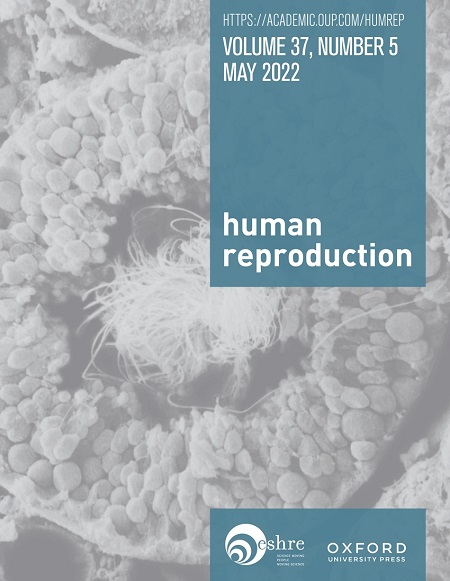O-134 Predictive value of seminal oxidation-reduction potential (ORP) and sperm DNA fragmentation (SDF) analysis for reproductive outcomes of intracytoplasmic sperm injection (ICSI) cycles
IF 6.1
1区 医学
Q1 OBSTETRICS & GYNECOLOGY
引用次数: 0
Abstract
Do seminal oxidation-reduction potential (ORP) and sperm DNA fragmentation (SDF) predict ICSI cycle outcomes? Both SDF and seminal ORP have strong prognostic value in predicting good fertilization (≥80%), blastocyst development (≥60%), clinical pregnancy and live birth. Seminal oxidative stress (OS) has been found to play an important role in various aetiologies of male infertility and is induced by the imbalance between reactive oxygen species (ROS) and antioxidants. OS is a major cause of sperm DNA fragmentation (SDF). It is well established that high levels of seminal OS and SDF are negatively associated with ART outcomes. Previous studies have associated high levels of SDF with an increase risk of miscarriage and a decrease in live birth rate. This prospective study included 144 couples who had a fresh autologous ICSI cycle between June 2018 and December 2020. There was no restriction to patients with severe male factor infertility. All cryopreservation and third party assisted reproductive techniques were excluded. This multi-centre study was performed at three ART Clinics in Cape Town, South Africa. All couples included in the study had fresh autologous ICSI cycles with freshly ejaculated semen. Seminal ORP testing was performed using the MiOXSYS system and SDF by means of a fluorescence microscopic TUNEL assay on freshly ejaculated semen samples that were used for ICSI. The ART outcomes evaluated were fertilization rate, blastocyst development rate, clinical pregnancy rate and live birth rate. The study shows that seminal ORP significantly negatively correlates with fertilization rate (r=-0.267; P = 0.0012), blastocyst development rate (r=-0.389; P < 0.0001), pregnancy (r=-0.296; P = 0.0003) and live birth (r=-0.353; P < 0.0001). ROC curve analysis shows significant predictive power for ORP for fertilization (≥80%; AUC=0.652; P = 0.0012), blastocyst development rate (≥60%; AUC=0.762; P < 0.0001), pregnancy (AUC=0.677; P = 0.0002) and live birth (AUC=0.729; P < 0.0001). Comparable results were obtained for SDF. An average cut-off value for ORP of 0.55 mV/106 sperm/mL was calculated. The AUCs between the SDF and ORP results for all reproductive outcome parameters did not differ. For all reproductive outcome parameters, normal sperm morphology shows the lowest predictive power. ORP with male age as confounding factor had significant effects on odds ratios (OR) of fertilization (OR = 0.1446; CI: 0.048-0.430; P = 0.0001) and blastocyst development (OR = 0.2468; CI: 0.095-0.635; P = 0.0029), while it was not significant for pregnancy and life birth. Multivariate logistic regression with fertilization, blastocyst development, pregnancy and live birth as dependent parameters and high/low seminal ORP, primary and secondary infertility, unexplained infertility, polycystic ovaries, endometriosis, tubal factor myomectomy, ovarian insufficiency and advanced maternal age as independent variables showed overall model fits (P < 0.0002) with a significant (P < 0.0084) influence of ORP on all reproductive outcome parameters. Since only ICSI patients were included in this study, this might have contributed to the fact the cut-off value of ORP is lower than the published cut-off. A further limitation is the use of a fluorescence microscopic TUNEL assay which drastically limited the number of sperm evaluated. This is the first study showing predictive value of seminal ORP for reproductive outcome including pregnancy and live birth. The method is easy and much quicker than current methods for the determination of SDF. Hence, it can be used a point of care method. Not applicableO-134 精子氧化还原电位(ORP)和精子DNA断裂(SDF)分析对卵浆内单精子注射(ICSI)周期生殖结果的预测价值
精液氧化还原电位(ORP)和精子DNA片段化(SDF)能预测ICSI周期的结果吗?SDF和精液ORP在预测良好受精(≥80%)、胚泡发育(≥60%)、临床妊娠和活产方面具有很强的预后价值。精氨氧化应激(OS)在男性不育的各种病因中起着重要作用,是由活性氧(ROS)和抗氧化剂之间的失衡引起的。OS是精子DNA断裂(SDF)的主要原因。众所周知,高水平的精原性OS和SDF与ART结果呈负相关。先前的研究表明,高水平的SDF会增加流产风险和降低活产率。这项前瞻性研究包括144对在2018年6月至2020年12月期间进行了新的自体ICSI周期的夫妇。对于严重男性因素不孕的患者没有限制。所有冷冻保存和第三方辅助生殖技术均被排除在外。这项多中心研究在南非开普敦的三家ART诊所进行。纳入研究的所有夫妇都有新鲜的自体ICSI周期和新鲜射出的精液。使用MiOXSYS系统和SDF,通过荧光显微镜TUNEL测定法对用于ICSI的新鲜精液样本进行精液ORP测试。评估的ART结果包括受精率、胚泡发育率、临床妊娠率和活产率。研究表明,精液ORP与受精率呈显著负相关(r=-0.267;P = 0.0012)、胚泡发育率(r=-0.389;P < 0.0001)、妊娠(r=-0.296;P = 0.0003)和活产(r=-0.353;P < 0.0001)。ROC曲线分析显示ORP对受精的显著预测能力(≥80%;AUC=0.652;P = 0.0012),胚泡发育率(≥60%;AUC=0.762;P < 0.0001)、妊娠(AUC=0.677;P = 0.0002)和活产(AUC=0.729;P < 0.0001)。SDF获得了可比较的结果。ORP的平均截止值为0.55 计算mV/106精子/mL。所有生殖结果参数的SDF和ORP结果之间的AUC没有差异。对于所有生殖结果参数,正常精子形态显示出最低的预测能力。以男性年龄为混杂因素的ORP对受精比值比(OR)有显著影响 = 0.1446;CI:0.048-0.430;P = 0.0001)和胚泡发育(OR = 0.2468;CI:0.095-0.635;P = 0.0029),而对妊娠和终身分娩没有显著影响。以受精、胚泡发育、妊娠和活产为依赖参数,以高/低精液ORP、原发性和继发性不孕、不明原因不孕、多囊卵巢、子宫内膜异位症、输卵管因子子宫肌瘤切除术、卵巢功能不全和高龄产妇为自变量的多因素logistic回归显示总体模型拟合(P < 0.0002),显著性(P < 0.0084)ORP对所有生殖结果参数的影响。由于本研究仅包括ICSI患者,这可能导致ORP的临界值低于公布的临界值。进一步的限制是使用荧光显微镜TUNEL测定法,该测定法极大地限制了所评估的精子数量。这是第一项显示精液ORP对生殖结果(包括妊娠和活产)的预测价值的研究。该方法简单,比目前测定SDF的方法快得多。因此,它可以作为一种护理点方法。不适用
本文章由计算机程序翻译,如有差异,请以英文原文为准。
求助全文
约1分钟内获得全文
求助全文
来源期刊

Human reproduction
医学-妇产科学
CiteScore
10.90
自引率
6.60%
发文量
1369
审稿时长
1 months
期刊介绍:
Human Reproduction features full-length, peer-reviewed papers reporting original research, concise clinical case reports, as well as opinions and debates on topical issues.
Papers published cover the clinical science and medical aspects of reproductive physiology, pathology and endocrinology; including andrology, gonad function, gametogenesis, fertilization, embryo development, implantation, early pregnancy, genetics, genetic diagnosis, oncology, infectious disease, surgery, contraception, infertility treatment, psychology, ethics and social issues.
 求助内容:
求助内容: 应助结果提醒方式:
应助结果提醒方式:


